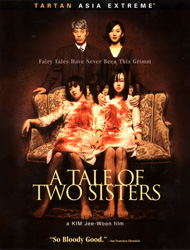Film
Index
Synopsis: Two sisters, Su-Mi and Su-Yeong, return home after a stay in a mental institution. They are happy to be home, at first, and wander around the countryside surrounding their home in an summer idyll before entering the house to face their stepmother. Thing inside the house aren't so rosy. Their relations with their stepmother are strained at best. At night, the girls are tormented by terrifying visions of spectral visitors. Things are not right with their stepmother, either, whose facade begins to crack during a particularly awkward dinner party, a party that is demolished when one of their guests has a seizure, then sees a phantom of her own under the kitchen sink. Meanwhile, Su-Mi begins to suspect her stepmother of abusing her younger sister, Su-Yeong. A confrontation seems inevitable...
Seven Types of Ambiguity: When I set out to write this review, I thought seriously about omitting a synopsis. The one I've provided takes the film to roughly the half-way point, but summarizing anything beyond that point would rob the viewer of discovering the film for themselves and may well be impossible in the first place. Once the film hits the halfway point, in which the identity of at least one of the ghosts is revealed, A Tale of Two Sisters begins to twist itself away from a stock Asian horror movie and rushes headlong into an epistemological head game that defies easy synopsis. I can't tell you what happens during the second half of the film because I'm not entirely sure of what happens during the second half of the film myself. I've described this film to friends as the product that might result if you were to cross The Ring with Mulholland Drive. But even that doesn't really describe the movie.
The set-up is pure fairy tale, with our two sisters playing Cinderella to their wicked stepmother. The iconography is borrowed wholesale from the current crop of Asian horror movies, with their long-haired ghost girls and their slow-burn of mounting dread. But the movie detonates all of these elements in the second half. The principal clue to the whole thing is at the beginning of the movie, set in the mental institution. The movie suggests at the outset that everything we see is provided by an unreliable narrator (a la The Turn of the Screw and certain stories by Shirley Jackson, especially The Sundial). The impedimenta of the horror movie often stands in for psychological phenomena; this movie fuses the two. Is there a hint of reality to be found the film's ambiguous second half? Maybe. I have my own ideas, but others may draw different conclusions.
Things that go bump in the night: Although the ultimate aim of the elements of horror in A Tale of Two Sisters may be very different in their effects than one is used to in horror movies, these elements are deployed by an expert hand to devastating effect. The girl under the sink at the dinner party is a good example of what I'm talking about: The audience knows she's there. The audience knows they are being set up. And the filmmakers "get" them anyway. This scene, like the rest of the movie, shows a razor sharp sense of timing. Many of these types of scenes in the film are intensified by the relative leisure of the daytime passages that separate them.
The most striking thing about the film is its visual beauty. Director Ji-Woon Kim, cinematographer Mo-Gae Lee, and art director Geun-hyeon Jo have lovingly mounted the film in a rich environment of textures and saturated colors. The film presents the most attractive haunted house since the first version of The Haunting. While the beauty of the film is the most striking thing about it, the overall effect of its assembled elements is what makes the film unique among contemporary horror movies. While the film is profoundly scary in parts, its ultimate aim is a deeply felt sorrow.

2/23/05